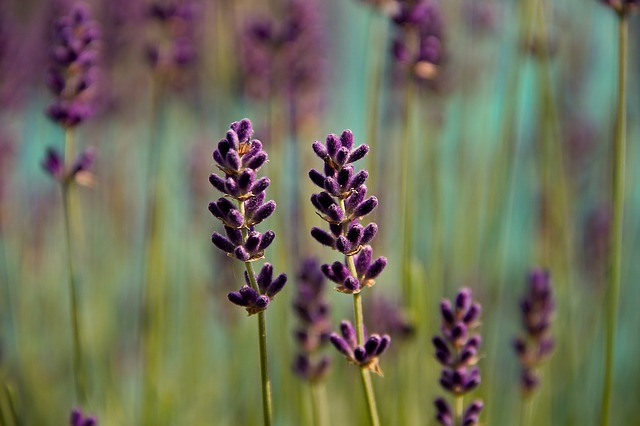 Lavender is a description of a group of plants that belong to the lavendula genus of flowering plants. Lavender is used therapeutically as a mood stabiliser, and in this regard perhaps the most common specie of lavender for this use is Lavandula angustifolia or English lavender. Other common forms of lavender include Lavandula latifolia, a Mediterranean grass-like lavender, Lavandula stoechas, which has butterfly-like bracts on top of the flowers and is also called French lavender; and Lavandula x intermedia, which is a sterile cross between Lavandula angustifolia and Lavandula latifolia. Slight differences in the chemical compositions of the various lavender plants may explain slight differences in the biological activities of the plants observed in studies and anecdotally reported through traditional medicine. Lavender oil is produced commercially by steam distilling the aerial parts of the plant, and often this oil is used in aromatherapy for its relaxing properties.
Lavender is a description of a group of plants that belong to the lavendula genus of flowering plants. Lavender is used therapeutically as a mood stabiliser, and in this regard perhaps the most common specie of lavender for this use is Lavandula angustifolia or English lavender. Other common forms of lavender include Lavandula latifolia, a Mediterranean grass-like lavender, Lavandula stoechas, which has butterfly-like bracts on top of the flowers and is also called French lavender; and Lavandula x intermedia, which is a sterile cross between Lavandula angustifolia and Lavandula latifolia. Slight differences in the chemical compositions of the various lavender plants may explain slight differences in the biological activities of the plants observed in studies and anecdotally reported through traditional medicine. Lavender oil is produced commercially by steam distilling the aerial parts of the plant, and often this oil is used in aromatherapy for its relaxing properties.
The essential oil in lavender is a complex mixture of aromatic compounds. This complexity makes chemical identification of all of the components difficult, and this complexity is hampered by slight differences in composition between different plants of the same species depending on factors such as the age of the plant and the growing conditions. The main constituents of lavender essential oil that have been identified to date are linalool, linalyl acetate, 1,8-cineole, β-ocimene (usually both cis and trans-), terpinen-4-ol and camphor. The amount of each component differs considerably between plants and so the medicinal effects of any treatments may vary slightly. Certain plants such as Lavandula stoechas and Lavandula lanata have high camphor levels, whereas other plants such as Lavandula angustifolia, Lavandula dentata and Lavandula pinnata are low in camphor (around 2 %). However, the low camphor plants tend have greater amounts of terpenes (e.g. -phellandrene) and sesquiterpenes (e.g. caryophyllene).

One study demonstrated that just one session of aromatherapy with lavender (1 % Lavender angustifolia) was significantly effective at reducing anxiety in patients in intensive care.
The inhaled volatile compounds in lavender essential oil are evidenced to have central nervous system effects in humans and animals. Inhaled volatile compounds are believed to work by modification of the limbic system of the brain. In this regard these compounds may modify the amygdala and hippocampal regions. It has been suggested that lavender volatiles may have a similar mode of action to benzodiazepine drugs through an ability to enhance the activity of the GABA system of neurotransmission. In addition, linalool from lavender may increase levels of acetylcholine in the brain. Both linalool and linalyl acetate are absorbed rapidly through the skin and reach peak plasma levels around 19 minutes after application. Linalyl acetate acts as a narcotic and linalool may act as a sedative. This makes lavender an effective sleep inducer. Studies investigating the effects of lavender have supported the contention that it is able to induce sleep, relaxation and has a calming effect in humans and animals. Oral consumption of lavender extracts are also effective in this way.
Eat Well, Stay Healthy, Protect Yourself
RdB
